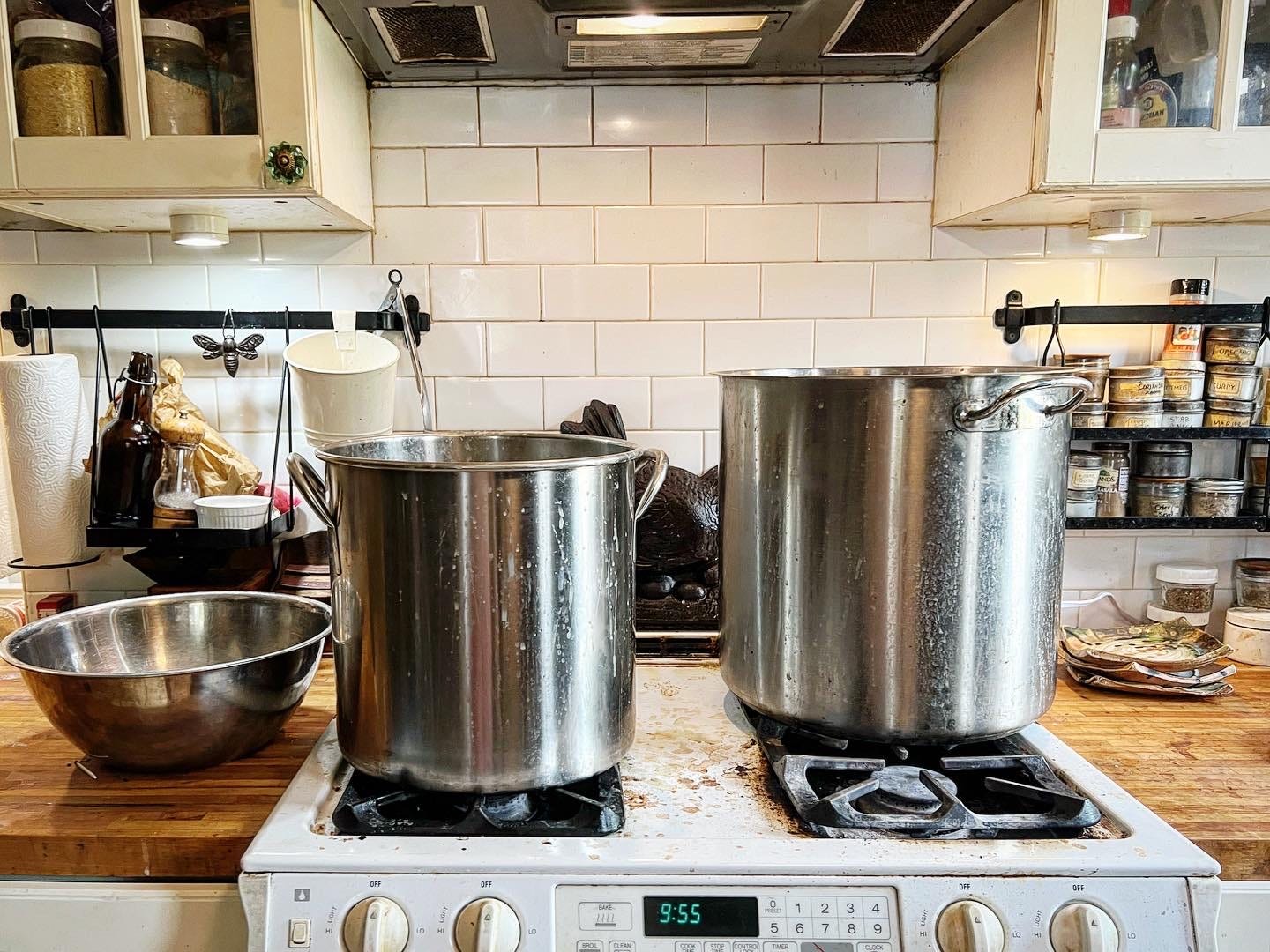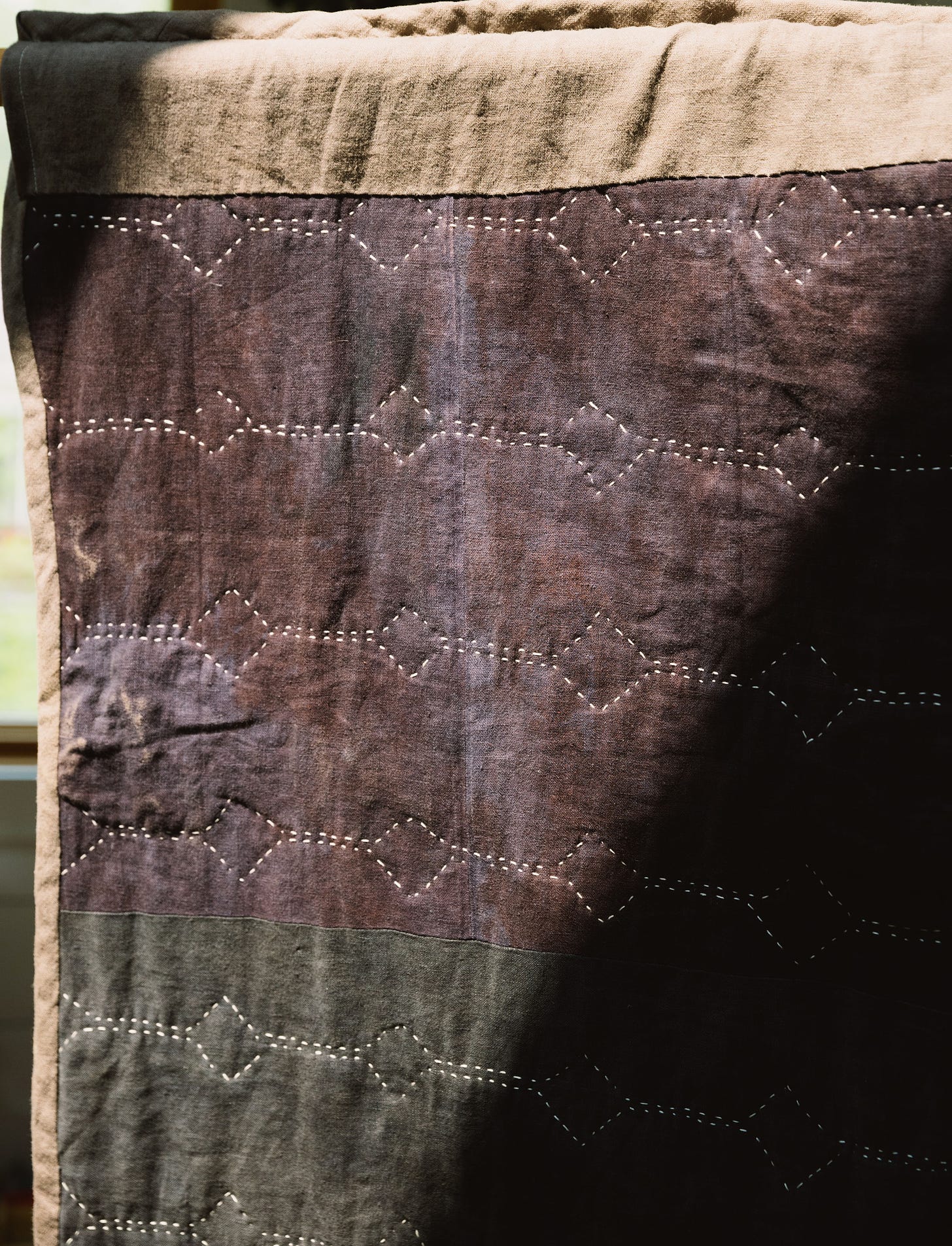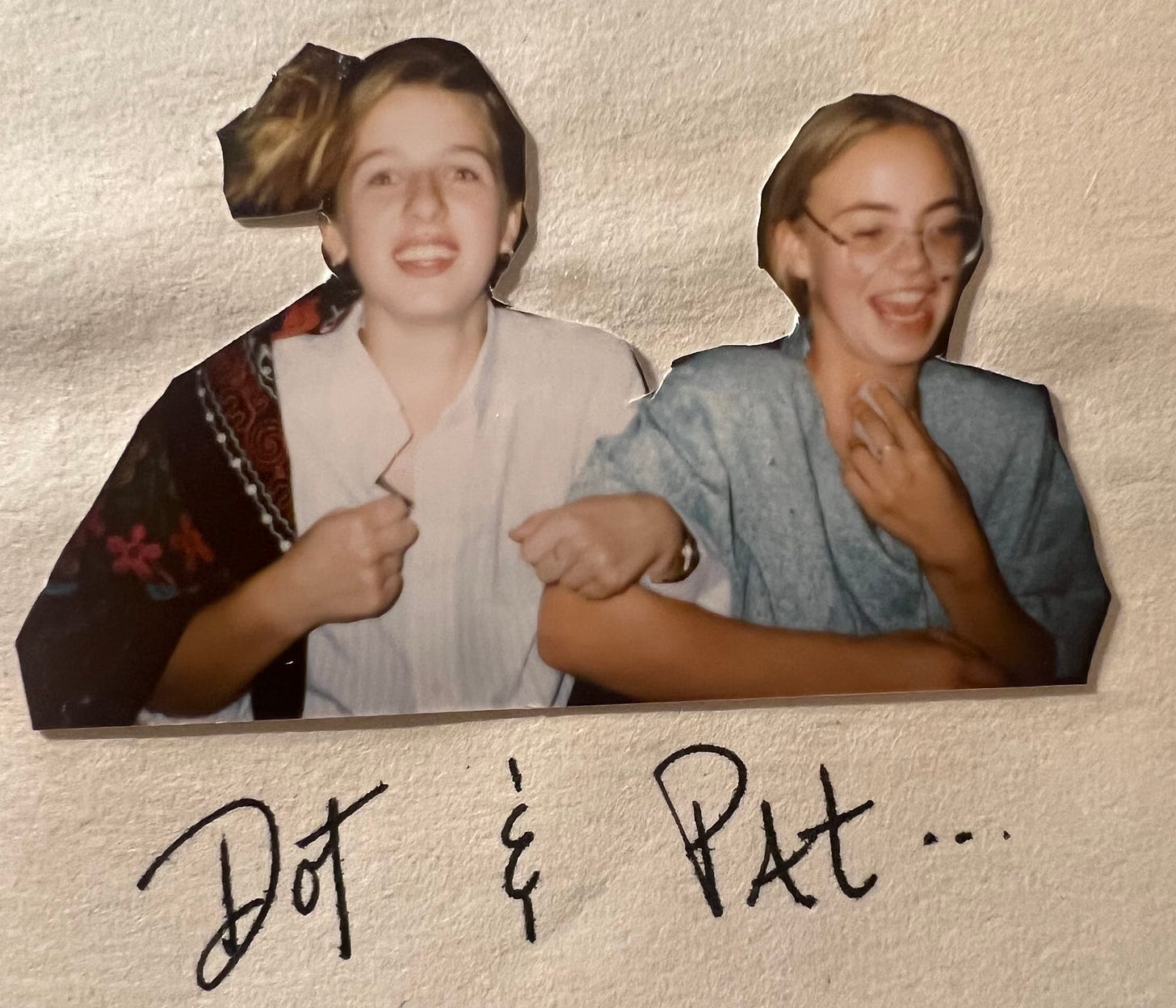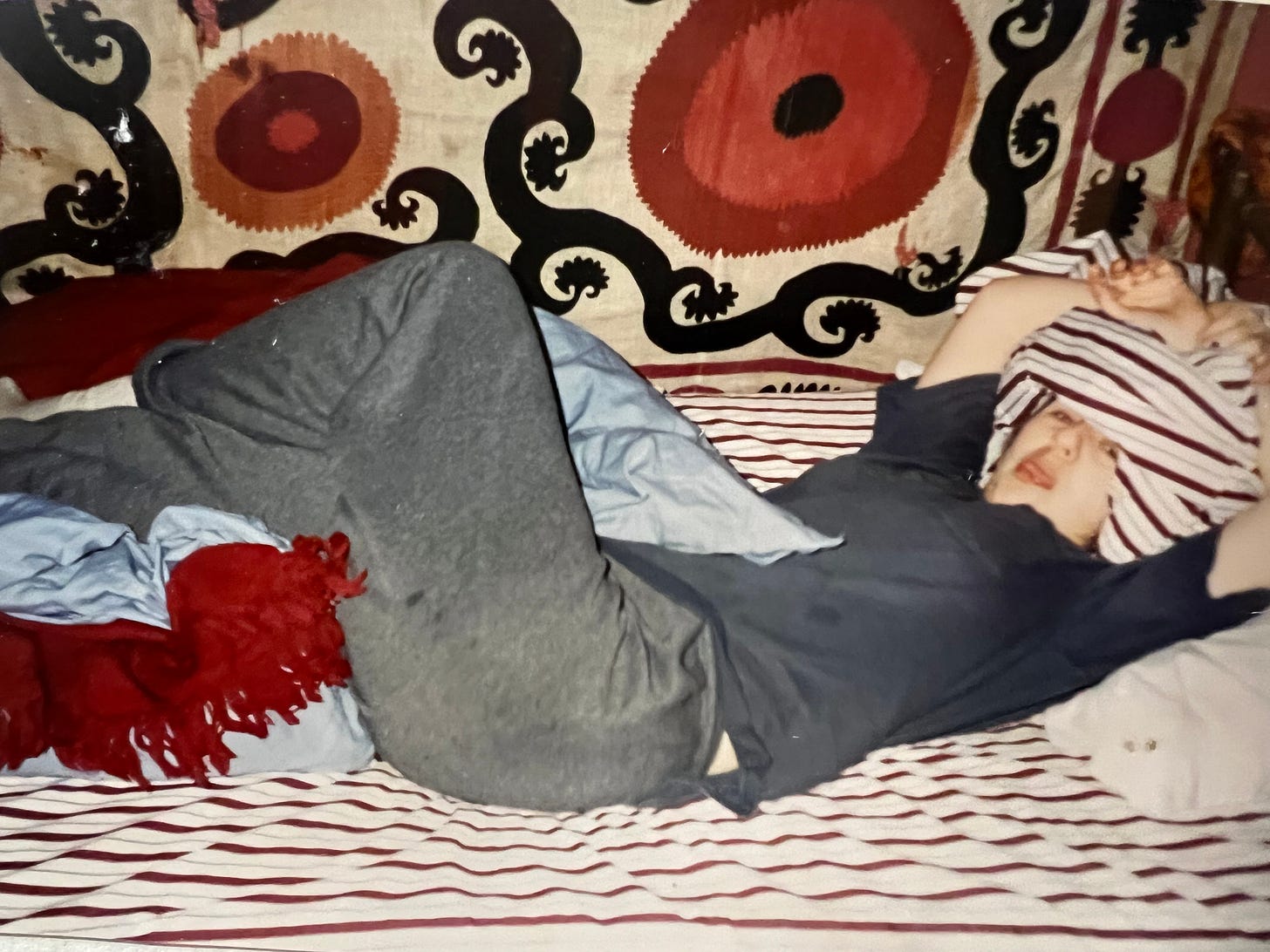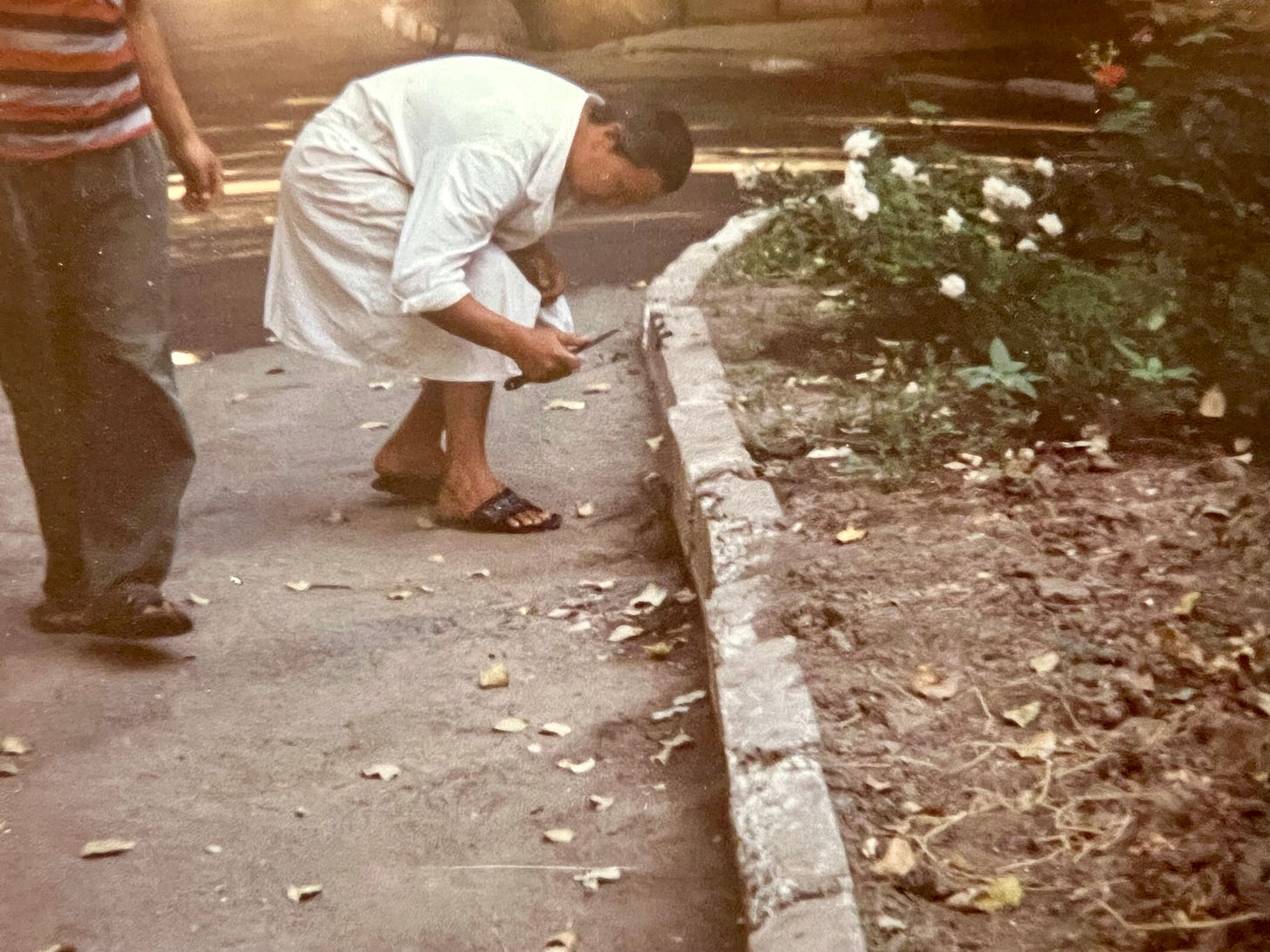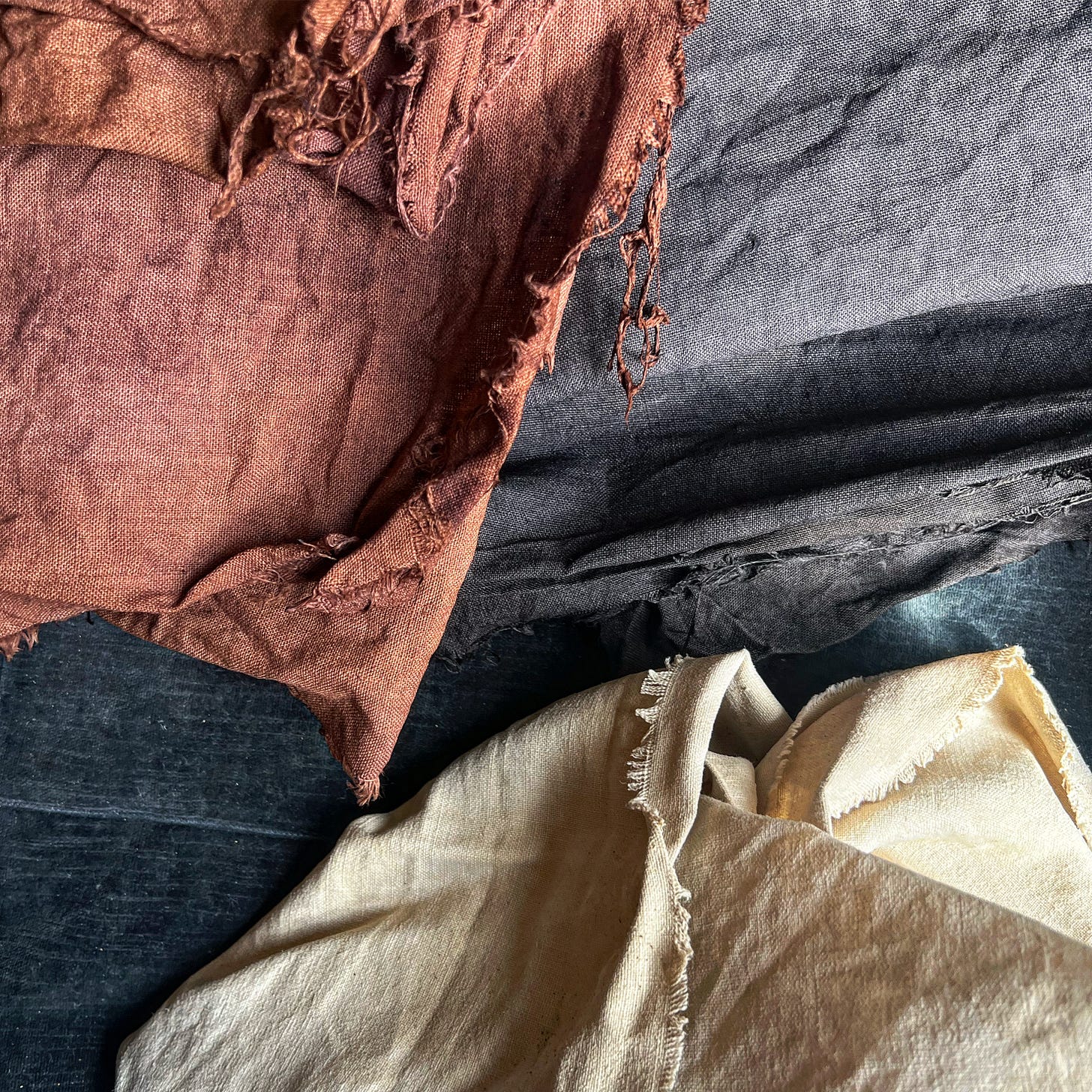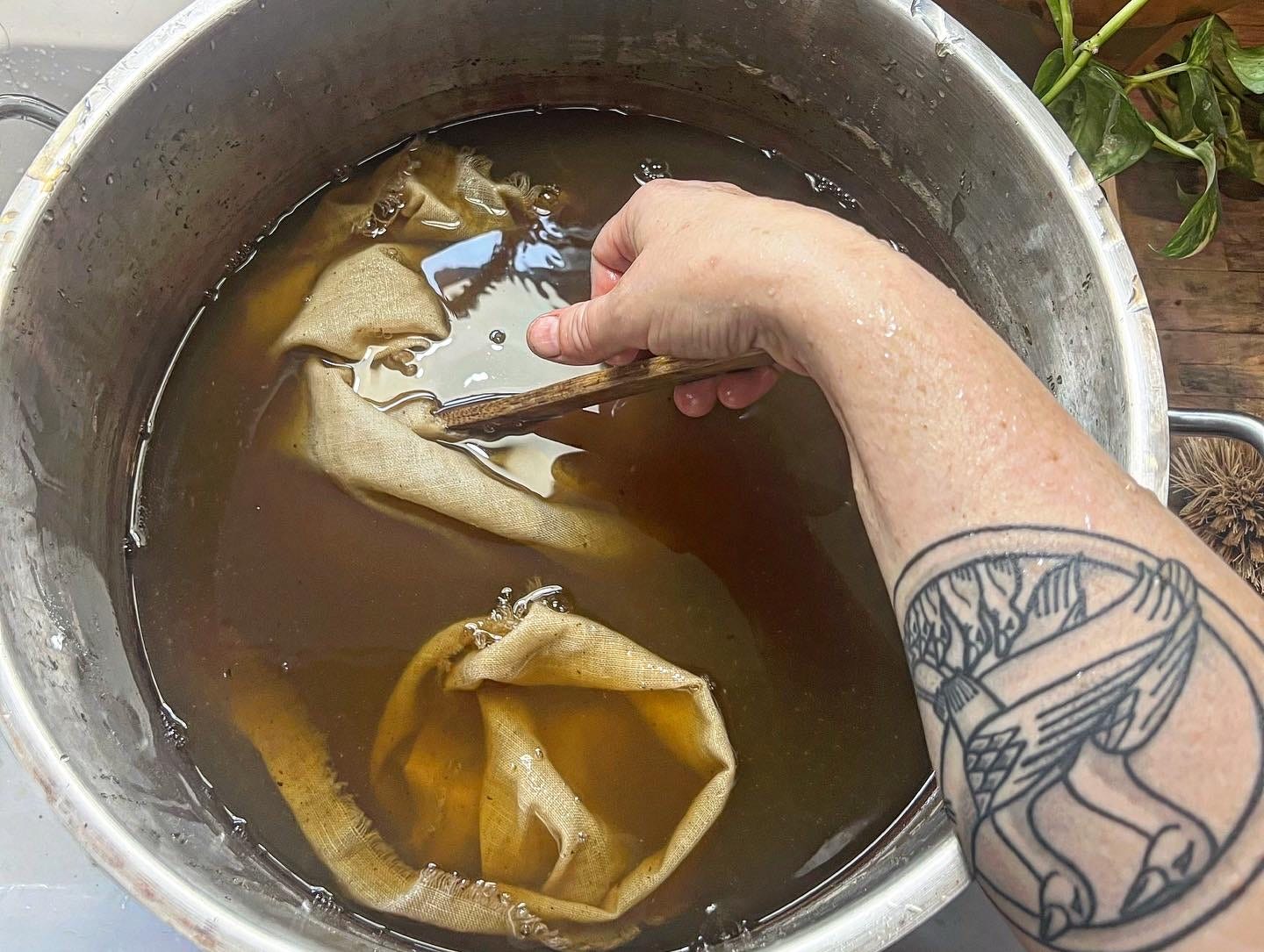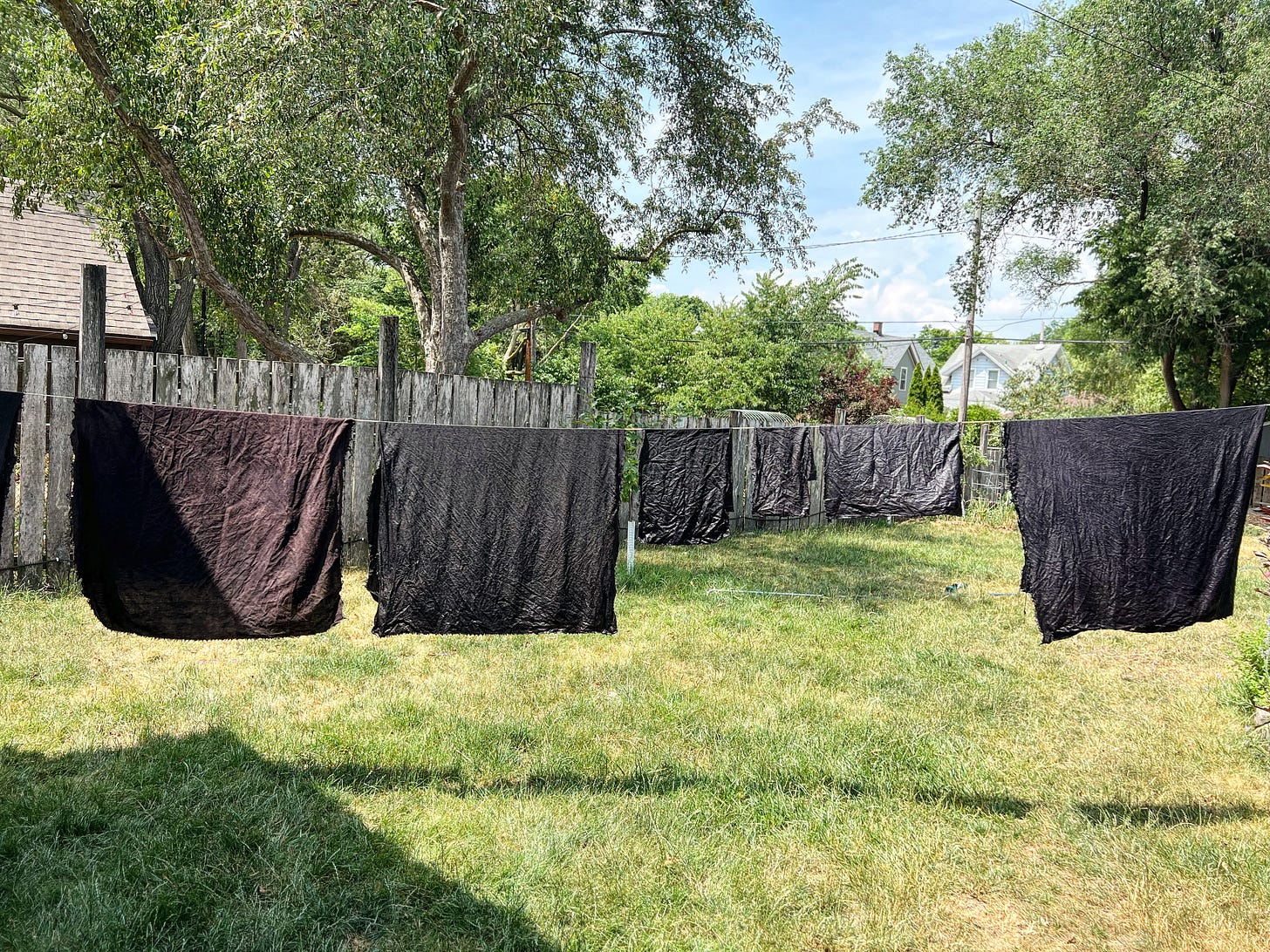

Discover more from Pelican Quilts
I’m never more witchy than when I stand in front of my caldrons. My natural dye pots steam up the room as I stand in front to stir - dressed all in black, mole growing on my chin.
Words like alchemy and potion are conjured into the air. I repeat the recipes and notes, hexes falling off my tongue. I’m a harpy, a hag, a vixen, a fury. A shrew. All this excess labor to achieve a color you can purchase for pennies. These arts are based in secret knowledge. Elements found deep in the woods, made from bark, leaves and insects. I collect the fruit of the mycelium whose fingers stretch up from the forest floor and out the corpses of trees. Arcane guides are handed down from woman to woman, inviting men only when they access feminine energies. This is a practice of making magic.
I stir my vat, jot notes in my logs. I add a morsel of this, a smidgeon of that. I wonder at the notes from those who came before with their strong magic. My cabinets are overflowing with dead flowers, twigs, powders, seeds and nuts. Shelves are burdened with insects and metal salts. I send off to purveyors of dye stuffs that were used for a thousand years.
Later when I stitch the cloth together, the rhythms of pattern and thread sing back to me as prayers and chants. I fall under the spell. Each of my quilts contain a droplet of blood. I accidentally prick my finger and the quilt takes in its little sacrifice. This happens on every quilt I make and it always comes as a surprise. Prick!
Why do each of my quilts require this drop? I prick my finger because I work with super sharp needles. I love John James long darners numbers 1-5. They are long and thin, still strong enough and so sharp. But I still wonder about what the magic is doing in the quilt.
I am working on a series of essays and writings on color and the magic of natural dyes in my quilts. I’m a dabbler. I’m writing about the magic and the way it has come to me. And as all witches know, we have to pass down the wisdom that has been passed down to us.
I’ve been thinking a lot about witches lately. The only time I ever met someone I thought was a witch was many years ago. I met two women when I was traveling on the Silk Road through Central Asia on a bus. I was 19. We were going through the mountain ranges of Uzbekistan and Kazakstan. I spent a decade after high school traveling to every place I could scrounge up enough money to go. This wasn’t the first only partially thought out trip. Going through the mountains we were driving at breakneck speeds on tiny roads built on narrow switchbacks on cliff edges. I convinced myself that there were different rules for what was safe because we were in a different country. My recklessness in that time of my life makes my heart skip a beat. Here is the one journal entry I found from that trip. Both completely understated and yet completely dramatic. Luckily those days stayed with me even though I recorded almost no details.
1994, August - Down the Silk Road. TASKKENT - SUMMARKANT- BUKHARA.
Lots of traveling. HOT. Gross. SICK. Constipated. Diarrhea. Horrible to be sick and go into these smelly places. But it was so fun. Got yelled at by intrusive woman at hotel! Shopping disappointing. Interesting feast given in our honor. DOT & PAT - crazies living on the bus with us. Home again. August 23. Culture shock.
We stopped along the road at what must have been a bus stop, though I couldn’t see any signs to indicate it. I had cramps and no pain killers. I had been constipated but then as soon as I got on a 6 hour bus ride I had diarrhea cramps. I can’t believe that I managed not to sh*t my pants that day. I had several undignified moments during this trip that involved my intestinal problems but not that day. I was miserable. We picked up two women. “Witches.” They whispered softly together, looking up at me, holding strange items in their hands. Wild hair and wispy clothing. Through all my physical discomfort, they caught my imagination and even though I couldn’t understand their language, I imagined their yelling at me and wild gesticulations to be hexes and curses.
My assumption that they were witches probably says more about me than it did about them. I often found myself sure that I had encountered something supernatural in the middle of some crazy risky adventure I was taking. They came from a culture with markers that I didn’t know how to interpret. Symbols that felt magical and mysterious to me. They seemed like old crones with their pointed fingers and their wild yells at me. Why were they yelling at me? What did they see in me? My friend and I named them Dot & Pat. We talked about them for the rest of the trip. Looking through my journal from that year, I found this picture of us doing some kind of pre-TikTok skit.
This shopping was “disappointing?” Strange. I remember that I found this antique wall covering pictured below. It was huge, hand embroidered and filled with the most incredible colors and shapes. I don’t know if it was the romanic notion that I had found this on the Silk Road - that thread of a road that tied the textile trade from Asia to Europe for over a thousand years, the fact that it was meticulously handmade, antique or that I had found it across the world and brought it home with me, but this is the first textile that I fell in love with. I kept this on my wall for a decade and its still at home with me packed away with my treasures. This was my bedroom later that year.
During that same trip I saw a sheep be slaughtered. I thought I had been tough enough to watch that lamb die, but as soon as the smell hit my nose I blacked out. I managed to stay standing and make my way to the ground without falling. The only picture I have from the evening is this man who was sharpening the knife that he used.
That evening I was served an eyeball soup from that same lamb. I had a reoccurring nightmare since my childhood when I saw Indian Jones and the Temple of Doom where this same thing happens. Indy is served a bowl of soup and an eyeball pops up and stares at him. In my dreams, eyeballs showed up in all kinds of foods. Soup, soda and strawberry ice cream. After the eyeballs showed up in a meal while I was awake I never had that dream again. That was the dinner I referred to in my journal as an “an interesting feast given in our honor.” Interesting seems like such an understatement. Pulling that image which haunted me from my dreams into reality was magic. It was so shocking and hard, and even though the evening was a rough one, it felt like a magic spell was broken to free me from a haunting.
My friend Lindy Biller inspired me this witchy season when she did a nice round up of witches from literary history. From the unpredictable powerful guides of greek mythology to modern day witches as the lead characters of stories and all the women in-between. Challenging social norms, living on the outskirts of society, framed as evil or at least hostile toward the maternal and virginal, these women were members of a secret sisterhood. Did they have a special power, or just seem to? Maybe seeming to is just enough.
Do I believe in their magic? This is a tale of blood, witches, textiles and dreams. This a tale of some kind of magic. But its also a question of wisdom. The witch is often a symbol of the wise woman in myth and literature. But her wisdom isn’t a wisdom of knowledge but of strange and weird secrets handed down. Warnings and interpretations of dreams. She sees the patterns in the receptions in the cloth and in the tea leaves. Her wisdom doesn’t come from knowing the way we think of knowledge but a way of seeing and listening to the world. Maybe its from this same place where my favorite interpreter of dreams, Sigmund Freud drew his own practice. Maybe this is how he avoided the trap of talking too much and offering too much guidance. Perhaps Freud was a witch. One of the weird ones who helped people find the magic words that could changed their lives.
I’ll be turning back to my dye pots now with thoughts of these old Shakespearian witches in my head. I’m sending you these stories, this poem and this recipe on the last hour of the Halloween night. I hope you find some magic here.
Double, double toil and trouble; Fire burn and caldron bubble. Fillet of a fenny snake, In the caldron boil and bake; Eye of newt and toe of frog, Wool of bat and tongue of dog, Adder's fork and blind-worm's sting, Lizard's leg and howlet's wing, For a charm of powerful trouble, Like a hell-broth boil and bubble. Double, double toil and trouble; Fire burn and caldron bubble. Cool it with a baboon's blood, Then the charm is firm and good. Macbeth: IV.i 10-19; 35-38
Black Natural Dye
This black natural dye approach is centuries old. This recipe is my own approach from those I’ve learned from Maiwa Textiles, Botanical Colors and other sources through the years. Jennifer Angus and Donna Brown introduced me to natural dyes and their approach still influences me.
Supplies
Linen or Cotton (cellulose fabric.) I dye in batches of 1000g.
50 liter stainless steal pot (non-reactive)
Particle mask
Stainless steal tongs
wooden spoon
Small mixing bowls
Scale
Step One. Weigh the fabric.
Before wetting the fabric, weigh the fabric. I write the weight in small writing on the selvedge edge. (WOF and WOG stands for Weight of Fabric/Goods. WOF and WOG are used interchangeably.)
Step Two. Scouring.
Since new fabrics are treated with waxes, oils, and other finishes that will resist the dye, they must be cleaned well in a process called scouring. Used fabrics that were washed many times but may still have oils. These later I may simply throw into a hot washing machine. Washing soda, also know as soda ash or sodium carbonate (Na2CO3) makes fat and oil more water soluble. For more detailed instructions see Maiwa School of Textiles free lesson on scouring. This is what I use:
Synthrapol 1-2% WOF
Washing Soda. 4-6% WOF
Hold at temperature (180’F) for 30 min to 1 hour
Step Three. Dark Tannin.
I typically use cutch extract but if you are looking for a free option you can experiment with black walnut, or acorn which are a rich sources of tannin. I read that historically Gallo tannin was used but I love the warm undertones of the Cutch dye. If you let it sit overnight, make sure that the fabric doesn’t float above the surface as it will stain at the waterline.
Cutch Extract 10-15% WOF
Washing soda 1-2% (to redden and deepen the color)
Simmer for 2 hours (180-200’F)
Let sit 4-24 hours
Step Four. Mordant.
For av detailed description of step four and five, check out these instructions from Botanical Colors. Hot tap water is fine but you use a heat source don’t heat over 120’F. Heat source is not necessary.
About reuse and disposal: I reuse the mordant bath up to 3 times unless it becomes cloudy. Each time I “recharge” the mordant with 25% of the original amount. Fabrics don’t have to be remordanted between dyes and they don’t have to be used right away. The liquid can be safely disposed of down the kitchen sink.
Aluminum acetate dissolved in boiling water. 10-15% WOF.
Heat to 120’F
Sit for 45 min. Stir occasionally.
May allow to sit for 12-24 hours
Step Five. Calcium bath.
Calcium carbonate, also called chalk, is used to increase dye pick up. I wring out out the wet fabric from the mordant bath and add it directly to the calcium bath. The calcium carbonate affects the pH of the textile. I don't rinse out the fabric for making black but if I am dyeing something like madder that is pH sensitive I always rinse after this step.
Calcium Carbonate 5% WOF
Soak in room temp water for 15-30 minutes.
Air dry or tumble dry to Store or use immediately
Step Five. Logwood
Logwood makes a beautiful lavender or dark purple but it isn’t very light fast. I don’t use it often except when making black. When treated with an iron bath the color changes and it becomes more light stable. I start with the lower % of the logwood extract and add more if needed. Learn from my mistakes and don’t add more dye with the fabric in the pot. This Botanical Colors recipe for black calls for 20% WOF. More logwood will definitely create darker shades of black but I get away with 8-10%. This dye strikes fast but I like to leave it in for an hour.
Logwood Extract 8-10%
Heat to 160-180’F for 1 hour
Step Six: Iron Bath
This is the final step because I don’t want to cross contaminate my pots with iron. Some people do this step right after the cutch tannin. The iron reacts with the tannin to shift the color toward grey, which is called saddening and can be used after the tannin step.
Iron (ferrous sulfate)
Each time I make black from natural dye it turns out different. I love the warm, the purple, the grey, the darkest blacks. Let me know if you try. I would love to hear how your witchy little brew turns out.
Goodbye Halloween. See you again next year.





